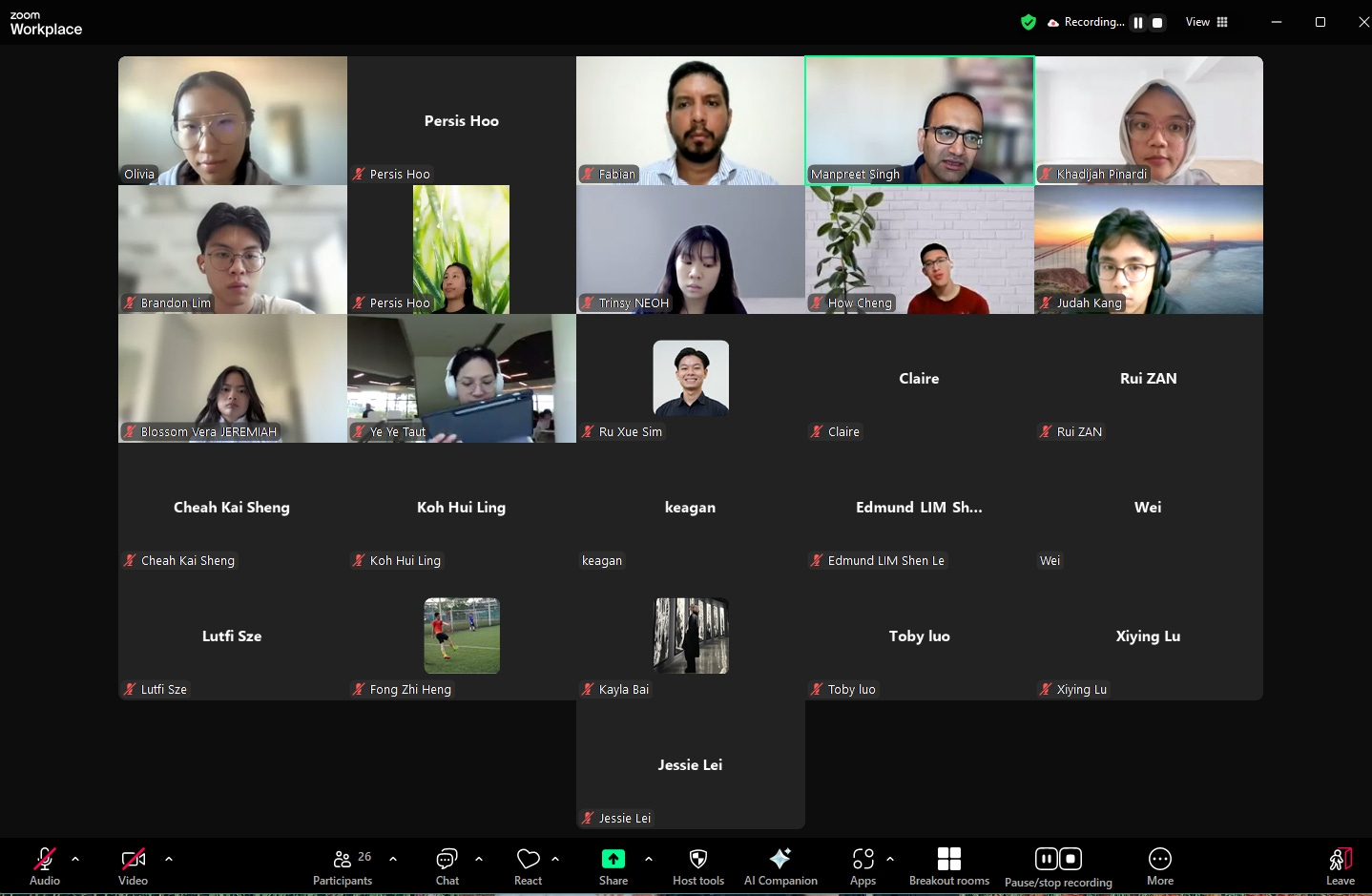Meet the Investor - Manpreet Singh - Veddis
This April, our Z Club members had the privilege of learning from Manpreet Singh, a seasoned investment professional who is currently working at Veddis, an Investment Company based in London.
This April, we had the privilege of meeting with Manpreet Singh from Veddis, an Investment Company based in London.
Manpreet Singh is a seasoned investment professional with over 15 years of experience in global equity and credit markets. Currently serving as a Portfolio Manager at Veddis, he oversees a diversified portfolio spanning high-growth equities, resilient income-generating assets, and special situations. His expertise lies in fundamental research-driven strategies, with a track record of generating alpha across sectors such as Energy, Financials, Retail, and Telecom.
Prior to Veddis, Manpreet held pivotal roles at leading institutions including Altavista Investment Management, Ronit Capital LLP, and Nomura’s proprietary trading team. He began his career as a Business Analyst at Monitor Group (Mumbai) and holds an MBA from the prestigious Indian Institute of Management Ahmedabad.
We are very grateful for the opportunity to meet with Manpreet and to learn from his extensive investment experience. Contained below are three of our members' reflections and takeaways from the sessions!
Reflection on the MTI with Manpreet – A Journey from Trader to Owner
Thanks for such an insightful and thought-provoking session. Hearing Manpreet’s personal evolution from a high-turnover long-short investor to a concentrated, conviction-driven long-term shareholder gave me a lot to reflect on. I was especially struck by the honesty with which he shared not only his successes but also the limitations and challenges of his past strategies. The shift from focusing on short-term price dislocations to truly understanding businesses "through cycles" really resonated with me. It reminded me that investing is not merely about numbers and timing, but about building trust and alignment with businesses and the people who run them.
One concept that deeply impacted me was the idea of investing as an “owner,” not a “trader.” The question Manpreet poses before each investment—“Would I be willing to own this company forever?”—is a powerful litmus test. It emphasizes how crucial conviction and deep understanding are. Too often, especially for newer investors like myself, there’s a temptation to chase opportunities based on surface-level metrics or recent performance, without truly grasping the long-term drivers or risks involved. Manpreet’s approach reminded me to slow down, go deeper, and focus more on quality and sustainability rather than immediacy.
His reflections on risk management were equally valuable. The framing of existential risk and the discipline to avoid low-quality businesses with unpredictable outcomes is something I will try to internalize. The honesty in saying “just because a stock is down doesn’t mean it’s cheap” or “don’t expect things to get better before you sell” felt both humbling and empowering. It shifted my perspective from seeing risk as volatility, to seeing risk as ignorance or overconfidence in what cannot be known. This nuanced view gave me a better framework to differentiate between short-term noise and real red flags.
One of the most valuable takeaways from the conversation with Manpreet was articulation of team culture and decision-making environment. His emphasis on transparency, humility, and a no-blame culture speaks to an organizational ethos that prioritizes clarity of thought and intellectual honesty over ego or hierarchy—a mindset that is critical for the success of a research-driven investment process.
What stood out to me most was Manpreet’s thoughtful transition from a fast-paced, trading-oriented approach to a slower, more research-driven and conviction-led style. It reflects not only strong discipline, but also an open-mindedness to evolve with experience. His inclusive attitude and willingness to share both successes and lessons openly made the session especially insightful. I walked away with a clearer sense of how to approach investing with greater patience, depth, and intention.
I’m truly grateful for the opportunity to join this online discussion—it was an eye-opening experience that deepened my understanding of long-term investing.
Warm regards,
Olivia ZHANG
During our session with Manpreet, several key insights were shared on long/short equity investing, business quality, risk management, and the dynamics of managing capital within a family office setting.
Investment Philosophy and Approach
Manpreet's equity strategy lies in identifying good businesses with strong tailwinds and resilient fundamentals — businesses that are not easily replaceable. For example, while a Michelin-starred restaurant may appear attractive, it lacks a sustainable moat. In contrast, a business like McDonald’s, although less glamorous, exhibits a much stronger competitive advantage.
Valuation discipline is equally important. Even the right business purchased at the wrong price is unlikely to generate attractive returns. The goal is to find high-quality businesses trading at reasonable valuations, with the ability to protect the downside.
Evaluating Business Quality
Key characteristics of an investable business include:
Having more tailwinds than headwinds in its industry.
Being difficult to replicate or replace.
Exhibiting a strong economic moat, such as high barriers to entry or capital-intensive infrastructure (e.g., Railroads. He gave us an example whereby a competitor might have the same financial resources to build another railroad but the market does not need 2 of such services).
Ensuring management incentive alignment — ideally, compensation structures that are variable and closely tied to long-term share price performance. Excessive focus on short-term stock movements is seen as a red flag.
Risk Management and Position Sizing
Manpreet distinguishes between acceptable risks and unmanageable uncertainties:
Regulatory risks, such as those facing online gambling firms, are sometimes worth taking if the downside is limited (e.g., a manageable fine). Position sizing is adjusted accordingly.
Broader macro or tariff-related risks are harder to hedge and generally avoided.
Attention is paid to obsolescence risk — for example, a company in a fast-changing industry like cybersecurity is at a higher risk of becoming obsolete, while market leaders in a traditional sector like traditional banking are more likely to remain relevant over the next five years.
In family office investing, risk tolerance is lower due to smaller balance sheets compared to banks. Mistakes in fixed income (FI) can be catastrophic, while equity mistakes are often more forgiving and easier to correct. For example, in pharmaceutical investing, a failed drug trial may wipe out value entirely, unlike other sectors where thesis revisions can lead to timely exits.
Diversification and Portfolio Construction
An ideal portfolio consists of 20 to 30 uncorrelated names. While some companies like Facebook and Amazon may seem diversified on paper, they often move together due to sector correlations. However, long-term "end destiny" should be the key criterion for diversification — not short-term price correlation. Manpreet noted that while it's difficult to mathematically prove uncorrelation with small data sets, qualitative judgment and deep reading help build conviction.
In terms of return expectations, equities offer higher internal rates of return (IRRs), with the potential for doubling capital in five years at a 15% IRR. This differs from fixed income, where returns are capped and errors less forgiving.
AI and the Role of Discipline
AI has not yet transformed the investment process in a revolutionary way. Manpreet sees potential in evolving tools like Gemini and GPT for information gathering but is still waiting for breakthroughs that meaningfully impact decision-making.
He also emphasized that discipline outweighs technical skills. His background in computer science gave him problem-solving abilities and mental discipline — traits he finds more valuable than coding in day-to-day investing.
Exit Strategy and Capital Alignment
Knowing when to exit is crucial. It’s better to sell when the thesis has changed rather than hold out in hope for a turnaround. He reiterated the importance of having aligned incentives between the investor and the principal, particularly in family offices. These conversations about risk alignment must happen before significant drawdowns, not after.
Finally, he noted that Veddis Capital has limited cash on hand, implying the team is still able to uncover attractive investment opportunities — a testament to the idea that there are always pockets of value in the market.
Zhi Heng Fong
Manpreet’s discussion delivered a couple of gems in capital allocation and portfolio design. His insights on allocating capital were that you usually have few months to do so and more important is to keep that position as philosophy changes through time considering macroeconomics and the like. On portfolio design, his take is on investing well and if you get out to execute your trade, do it but it shouldn’t be the main objective.
Later on, his discussion went into the structure of the business, volume, pricing as his first things to see on a stock to buy. On a second layer in a business is its moat that is not easily replicable. The same is applied vice versa on family offices as his point of view is that you must diversify with at least 20 to 30 meaningful stock selections with a 10-year perspective on each segment and each stock to design a correlated portfolio.
Fabian Vera





